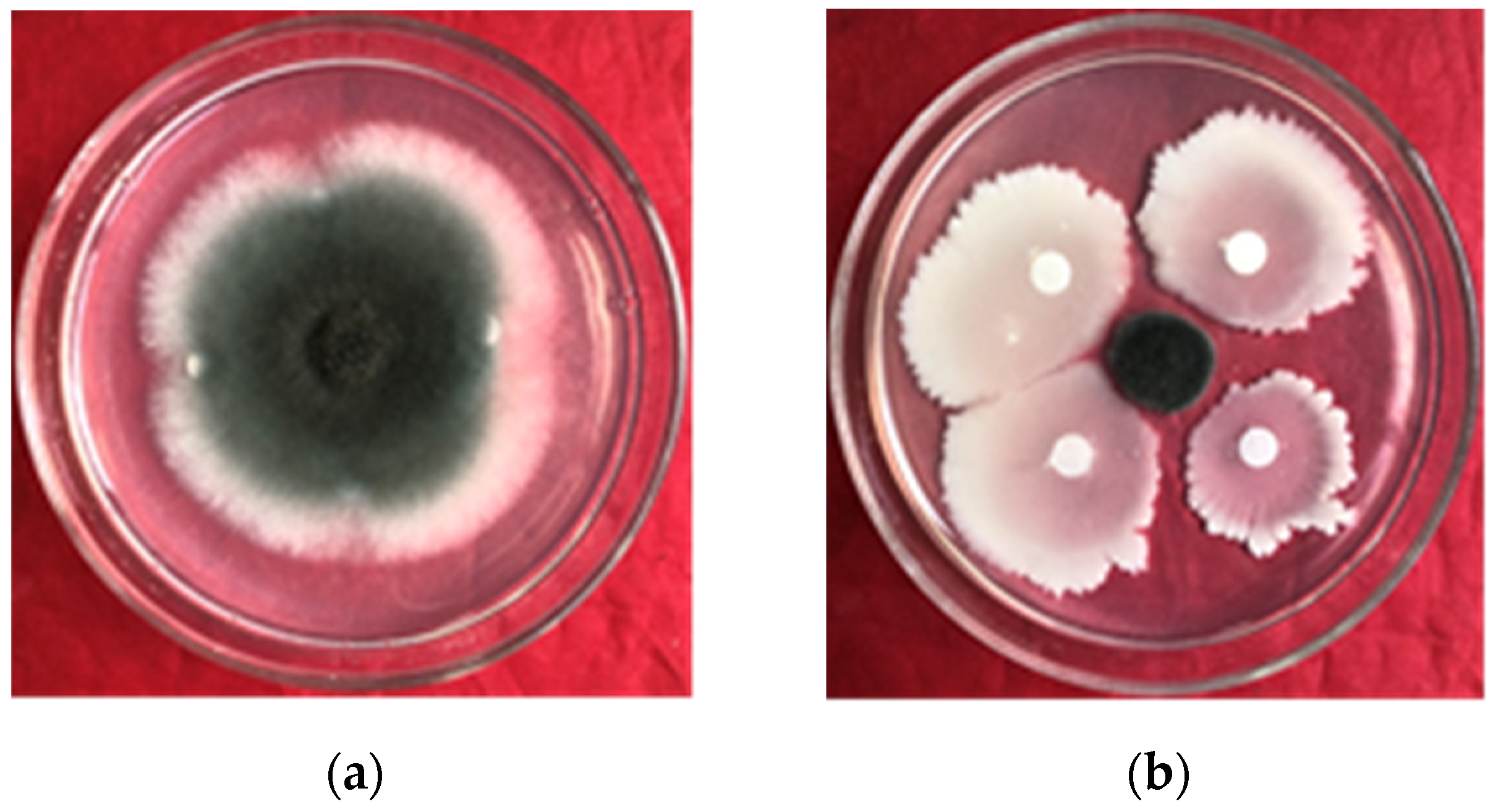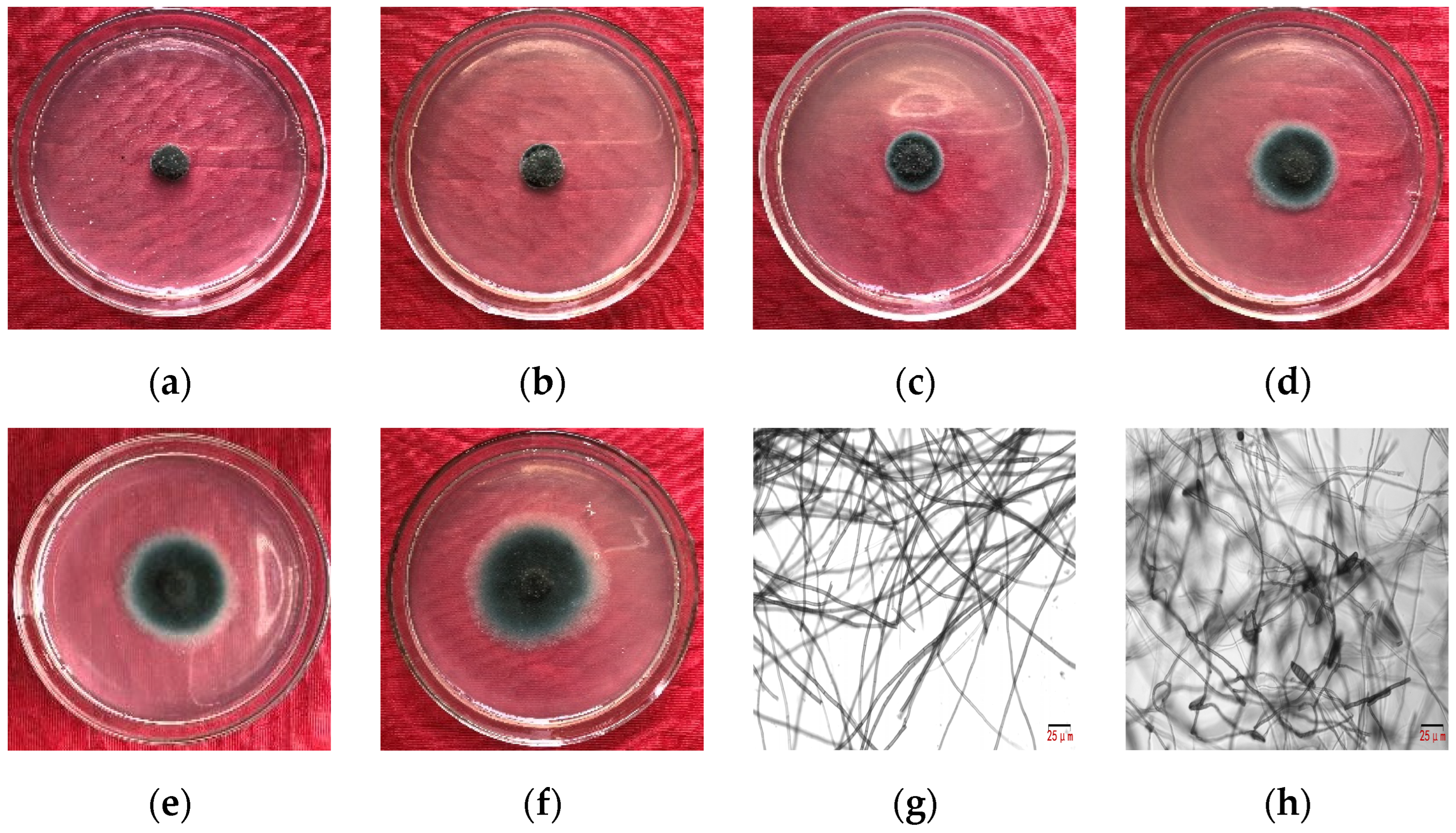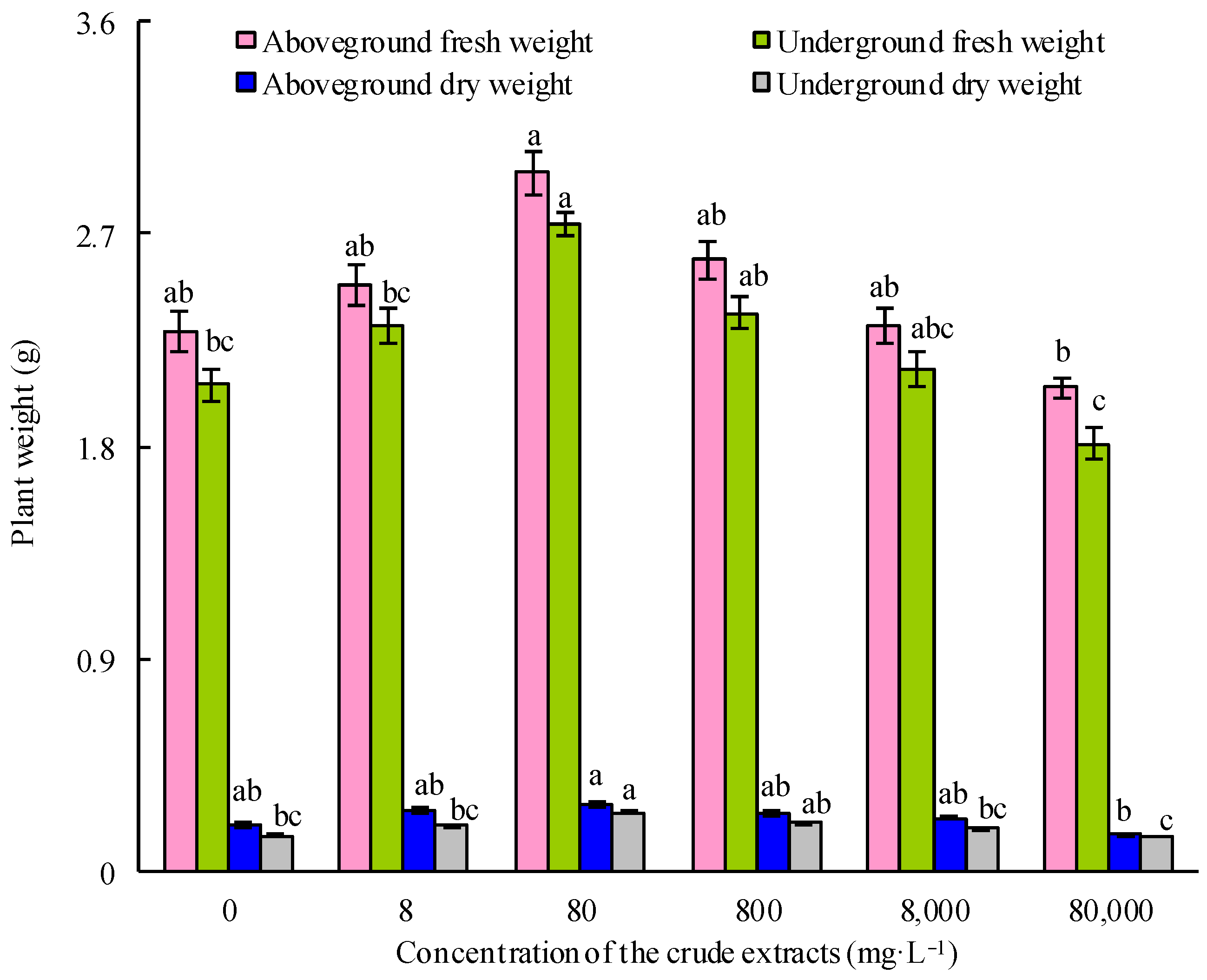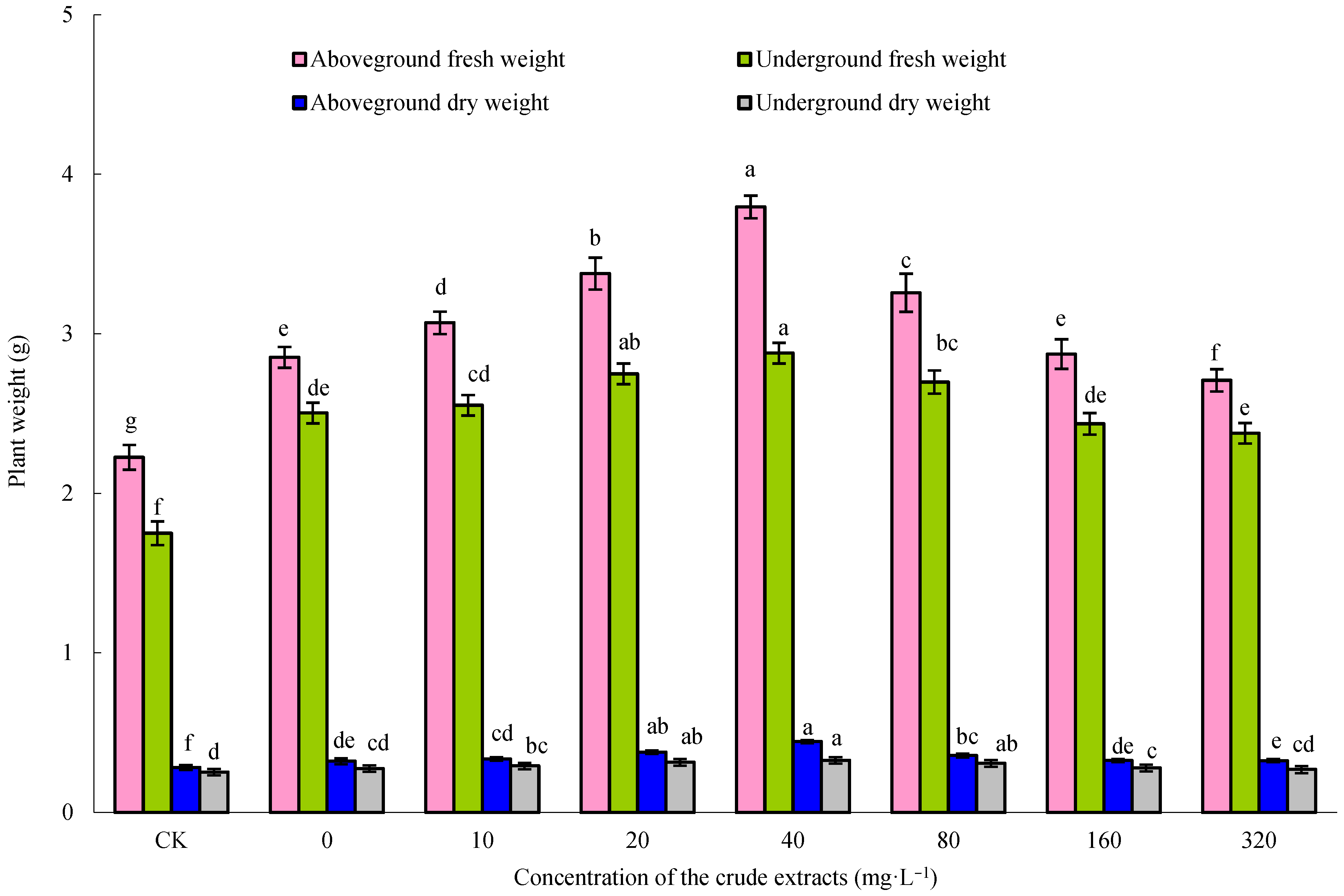Synergistic Effects of Chemical Fungicides with Crude Extracts from Bacillus amyloliquefaciens to Control Northern Corn Leaf Blight
Abstract
1. Introduction
2. Materials and Methods
2.1. Fungicides, Plant Materials, Pathogens, and Antagonistic Bacteria
2.2. Inhibition Effect of B. amyloliquefaciens gfj-4 on E. turcicum
2.3. Inhibitory Activity of Microbial Crude Extracts and Chemical Fungicides on E. turcicum
2.4. Synergistic Effects of Microbial Crude Extracts and Chemical Fungicides
2.5. Control Effects of Selected Combinations on NCLB
2.5.1. Control Effects In Vitro
2.5.2. Control Effects In Vivo
2.6. Effects of Maize Seeds Soaked with Crude Extracts of Fermentation Broth on the Growth of Maize Plants
2.7. Effects of Crude Extracts on the Growth of Maize Plants
2.7.1. Soil Preparation
2.7.2. Growth Promotion Effect Determination
2.8. Data Analysis
3. Results
3.1. Antagonistic Effects of B. amyloliquefaciens on E. turcicum
3.2. Inhibitory Effects of Crude Extracts and Chemical Fungicides on E. turcicum
3.3. Antagonistic Effects of the Combination of Microbial Crude Extracts and Chemical Fungicides
3.4. Control of Pathogen Infection on Maize Leaves with Microbial Crude Extracts and Pyraclostrobin
3.5. Enhancing Control Efficacy of E. turcicum on Maize Plants by Combining Microbial Crude Extracts and Pyraclostrobin
3.6. Growth-Promoting Effects of Microbial Crude Extracts on Maize Plants
4. Discussion
5. Conclusions
6. Patents
Author Contributions
Funding
Institutional Review Board Statement
Data Availability Statement
Conflicts of Interest
References
- Giulio, T.; Amedeo, R.; Massimo, B. Foliar fungicide application to maize: Yield and grain hardness enhancement in different environmental conditions. Crop Sci. 2015, 55, 1782–1790. [Google Scholar]
- Liu, H.; Guo, F.F.; Chen, X.L.; Wu, B.M. Temporal progress and spatial patterns of northern corn leaf blight in corn fields in China. Phytopathology 2022, 112, 1936–1945. [Google Scholar] [CrossRef] [PubMed]
- Liu, N.; Cao, Z.Y.; Cao, K.K.; Ma, S.X.; Gong, X.D.; Jia, H.; Dai, D.Q.; Dong, J.G. Identification of laccase-like multicopper oxidases from the pathogenic fungus Setosphaeria turcica and their expression pattern during growth and infection. Eur. J. Plant Pathol. 2019, 153, 1149–1163. [Google Scholar] [CrossRef]
- Ferguson, L.M.; Carson, M.L. Spatial diversity of Setosphaeria turcica sampled from the eastern United States. Phytopathology 2004, 94, 892–900. [Google Scholar] [CrossRef] [PubMed]
- Badu-Apraku, B.; Bankole, F.A.; Fakorede, M.A.B.; Ayinde, O.; Ortega-Beltran, A. Genetic analysis of grain yield and resistance of extra-early-maturing maize inbreds to northern corn leaf blight. Crop Sci. 2021, 61, 1864–1880. [Google Scholar] [CrossRef]
- Fang, Y.L.; Zhou, Y.Y.; Li, X.; Gao, Y.; Wang, D.L.; Liu, M.J.; Zhang, Z.J. Histological characterization of the early-stage infection events of Setosphaeria turcica in maize. Plant Pathol. 2022, 71, 251–261. [Google Scholar] [CrossRef]
- De Rossi, R.L.; Guerra, F.A.; Plazas, M.C.; Vuletic, E.E.; Brücher, E.; Guerra, G.D.; Reis, E.M. Crop damage, economic losses, and the economic damage threshold for Northern corn leaf blight. Crop Prot. 2022, 154, 105901. [Google Scholar] [CrossRef]
- Navarro, B.L.; Romero, L.R.; Kistner, M.B.; Iglesias, J.; Von Tiedemann, A. Assessment of physiological races of Exserohilum turcicum isolates from maize in Argentina and Brazil. Trop. Plant Pathol. 2021, 46, 371–380. [Google Scholar] [CrossRef]
- Badu-Apraku, B.; Bankole, F.A.; Ajayo, B.S.; Fakorede, M.A.B.; Akinwale, R.O.; Talabi, A.O.; Bandyopadhyay, R.; Ortega-Beltran, A. Identification of early and extra-early maturing tropical maize inbred lines resistant to Exserohilum turcicum in sub-Saharan Africa. Crop Prot. 2021, 139, 105386. [Google Scholar] [CrossRef] [PubMed]
- Montemarani, A.; Sartori, M.; Nesci, A.; Etcheverry, M.; Barros, G. Influence of crop residues, matric potential and temperature on growth of Exserohilum turcicum an emerging maize pathogen in Argentina. Lett. Appl. Microbiol. 2018, 67, 614–619. [Google Scholar] [CrossRef] [PubMed]
- Grichar, W.J.; Janak, T.W.; McGinty, J.A.; Brewer, M.J. Using biostimulants, soil additives, and plant protectants to improve corn yield in South Texas. Agronomy 2023, 13, 1429. [Google Scholar] [CrossRef]
- Zhang, G.Z.; Wang, F.T.; Qin, J.C.; Wang, D.; Zhang, J.Y.; Zhang, Y.H.; Zhang, S.H.; Pan, H.Y. Efficacy assessment of antifungal metabolites from Chaetomium globosum No.05, a new biocontrol agent, against Setosphaeria turcica. Biol. Control 2013, 64, 90–98. [Google Scholar] [CrossRef]
- Zhang, M.; Zhang, C.; Zhang, S.S.; Yu, H.L.; Pan, H.Y.; Zhang, H. Klebsiella jilinsis 2N3 promotes maize growth and induces resistance to Northern corn leaf blight. Biol. Control 2021, 156, 104554. [Google Scholar] [CrossRef]
- Ma, Y.; Li, Y.; Yang, S.; Li, Y.; Zhu, Z. Biocontrol potential of Trichoderma asperellum strain 576 against Exserohilum turcicum in Zea mays. J. Fungi 2023, 9, 936. [Google Scholar] [CrossRef] [PubMed]
- Mark, M.; Shiri, F. Prospects for biological soilborne disease control: Application of indigenous versus synthetic microbiomes. Phytopathology 2017, 107, 256–263. [Google Scholar]
- Kalinina, T.A.; Balandina, V.I.; Obydennov, K.L.; Slepukhin, P.A.; Fan, Z.J.; Bakulev, V.A.; Glukhareva, T.V. Synthesis, fungicidal activity and plant protective properties of 1, 2, 3-thiadiazole and isothiazole-based N-acyl-N-arylalaninates. Molecules 2023, 28, 419. [Google Scholar] [CrossRef] [PubMed]
- Sarli, D.A.; Sánchez, L.A.; Delgado, O.D. Burkholderia gladioli MB39 an antarctic strain as a biocontrol agent. Curr. Microbiol. 2021, 78, 2332–2344. [Google Scholar] [CrossRef] [PubMed]
- Toda, M.; Beer, K.D.; Kuivila, K.M.; Chiller, T.M.; Jackson, B.R. Trends in agricultural triazole fungicide use in the United States, 1992–2016 and possible implications for antifungal-resistant fungi in human disease. Environ. Health Perspect. 2021, 129, 55001. [Google Scholar] [CrossRef] [PubMed]
- Reynoso, A.; Sautua, F.; Carmona, M.; Chulze, S.; Palazzini, J. Tan spot of wheat: Can biological control interact with actual management practices to counteract this global disease? Eur. J. Plant Pathol. 2023, 166, 27–38. [Google Scholar] [CrossRef]
- Mikaberidze, A.; Paveley, N.; Bonhoeffer, S.; Van den Bosch, F. Emergence of resistance to fungicides: The role of fungicide dose. Phytopathology 2017, 107, 545–560. [Google Scholar] [CrossRef] [PubMed]
- Klocke, B.; Sommerfeldt, N.; Wagner, C.; Schwarz, J.; Baumecker, M.; Ellmer, F.; Jacobi, A.; Matschiner, K.; Petersen, J.; Wehling, P.; et al. Disease threshold-based fungicide applications: Potential of multi-disease resistance in winter wheat cultivars in Germany. Eur. J. Plant Pathol. 2023, 165, 363–383. [Google Scholar] [CrossRef]
- Yen, T.B.; Chang, S.T. Synergistic effects of cinnamaldehyde in combination with eugenol against wood decay fungi. Bioresour. Technol. 2008, 99, 232–236. [Google Scholar] [CrossRef] [PubMed]
- Carpane, P.D.; Peper, A.M.; Kohn, F. Management of Northern Corn Leaf Blight using Nativo (Trifloxistrobin+Tebuconazole) fungicide applications. Crop Prot. 2020, 127, 104982. [Google Scholar] [CrossRef]
- Silva, T.S.; Da Fonseca, L.F.; Yamada, J.K.; De Carvalho Pontes, N. Flutriafol and azoxystrobin: An efficient combination to control fungal leaf diseases in corn crops. Crop Prot. 2021, 140, 105394. [Google Scholar] [CrossRef]
- Luo, H.Y.; Meng, S.Y.; Deng, Y.C.; Deng, Z.Y.; Shi, H.L. In vitro antifungal activity of lasiodiplodin, isolated from endophytic fungus Lasiodiplodia pseudotheobromae J-10 associated with Sarcandra glabra and optimization of culture conditions for lasiodiplodin production. Arch. Microbiol. 2023, 205, 140. [Google Scholar] [CrossRef] [PubMed]
- Limdolthamand, S.; Songkumarn, P.; Suwannarat, S.; Jantasorn, A.; Dethoup, T. Biocontrol efficacy of endophytic Trichoderma spp. in fresh and dry powder formulations in controlling Northern corn leaf blight in sweet corn. Biol. Control 2023, 181, 105217. [Google Scholar] [CrossRef]
- Song, J.H.; Lei, T.Y.; Hao, X.J.; Yuan, H.Z.; Sun, W.; Chen, S.N. Synergistic effects of Clonostachys rosea isolates and succinate dehydrogenase inhibitors fungicides against gray mold on tomato. Microorganisms 2022, 11, 20. [Google Scholar] [CrossRef] [PubMed]
- Cun, H.C.; Munir, S.; He, P.F.; Wu, Y.X.; He, P.B.; Ahmed, A.; Che, H.B.; Li, J.; He, Y.Q. Diversity of root endophytic bacteria from maize seedling involved in biocontrol and plant growth promotion. Egypt. J. Biol. Pest Control 2022, 32, 129. [Google Scholar] [CrossRef]
- Matarese, F.; Sarrocco, S.; Gruber, S.; Seidl-Seiboth, V.; Vannacci, G. Biocontrol of Fusarium head blight: Interactions between Trichoderma and mycotoxigenic Fusarium. Microbiology 2012, 158, 98–106. [Google Scholar] [CrossRef] [PubMed]
- Ohno, A.; Ano, T.; Shoda, M. Production of a lipopeptide antibiotic, surfactin, by recombinant Bacillus subtilis in solid state fermentation. Biotechnol. Bioeng. 1995, 47, 209–214. [Google Scholar] [CrossRef] [PubMed]
- Liu, S.M.; Fu, L.Y.; Hai, F.; Jiang, J.; Che, Z.P.; Tian, Y.E.; Chen, G.Q. Sensitivity to boscalid in field isolates of Sclerotinia sclerotiorum from rapeseed in Henan Province, China. J. Phytopathol. 2018, 166, 227–232. [Google Scholar] [CrossRef]
- Wadley, F.M. The Evidence Required to Show Synergistic Action of Insecticides and a Short Cut in Analysis; U.S. Government Printing Office: Washington, DC, USA, 1945.
- Liu, C.Y.; Chang, Z. Identification of the biocontrol strain LB-2 and determination of its antifungal effects on plant pathogenic fungi. J. Plant Pathol. 2018, 100, 25–32. [Google Scholar] [CrossRef]
- Lu, X.M.; He, S.; Ma, H.J.; Li, J.H.; Zhu, F.X. Hormetic effects of flusilazole preconditioning on mycelial growth and virulence of Sclerotinia sclerotiorum. Plant Dis. 2018, 102, 1165–1170. [Google Scholar] [CrossRef] [PubMed]
- Erenstein, O.; Jaleta, M.; Sonder, K.; Mottaleb, K.; Prasanna, B.M. Global maize production, consumption and trade: Trends and R&D implications. Food Secur. 2022, 14, 1295–1319. [Google Scholar]
- Jean-Paul, C.; Giorgia, R.; Salvatore, D.F.; Giovanni, D.L.; Fabian, C. Agricultural diversification, productivity, and food security across time and space. Agric. Econ. 2022, 53, 41–58. [Google Scholar]
- Haasbroek, M.P.; Craven, M.; Barnes, I.; Crampton, B.G. Microsatellite and mating type primers for the maize and sorghum pathogen, Exserohilum turcicum. Australas. Plant Pathol. 2014, 43, 577–581. [Google Scholar] [CrossRef]
- Juthaporn, K.; Kamol, L.; Weerasak, S.; Jirawat, S.; Nooduan, M.; Piyada, T. Identification of RAPD and SCAR markers linked to northern leaf blight resistance in waxy corn (Zea mays var. ceratina). Euphytica 2009, 164, 615–625. [Google Scholar]
- Madias, A.; Borrás, L.; Gambin, B.L. Foliar fungicides help maize farmers reduce yield gaps in late sown crops in a temperate region. Eur. J. Agron. 2023, 145, 126768. [Google Scholar] [CrossRef]
- Weems, J.D.; Bradley, C.A. Sensitivity of Exserohilum turcicum to demethylation inhibitor fungicides. Crop Prot. 2017, 99, 85–92. [Google Scholar] [CrossRef]
- Testa, G.; Reyneri, A.; Cardinale, F.; Blandino, M. Grain yield enhancement through fungicide application on maize hybrids with different susceptibility to Northern corn leaf blight. Cereal Res. Commun. 2015, 43, 415–425. [Google Scholar] [CrossRef]
- Nelson, K.A.; Dudenhoeffer, C.J.; Burdick, B.; Harder, D. Enhanced efficiency foliar nitrogen and pyraclostrobin applications for high yielding corn. J. Agric. Sci. 2015, 7, 17–28. [Google Scholar] [CrossRef]
- Sartori, M.; Nesci, A.; García, J.; Passone, M.A.; Montemarani, A.; Etcheverry, M. Efficacy of epiphytic bacteria to prevent northern leaf blight caused by Exserohilum turcicum in maize. Rev. Argent. Microbiol. 2017, 49, 75–82. [Google Scholar] [CrossRef] [PubMed]
- Luo, H.Y.; Zhou, Q.Y.; Deng, Y.C.; Deng, Z.Y.; Qing, Z.; Sun, W.B. Antifungal activity of the extract and the active substances of endophytic Nigrospora sp. from the traditional Chinese medicinal plant Stephania kwangsiensis. Nat. Prod. Commun. 2017, 12, 1889–1892. [Google Scholar] [CrossRef]
- Zahra, M.B.; Fayyaz, B.; Aftab, Z.-E.; Akhter, A.; Bahar, T.; Anwar, W.; Haider, M.S. Characterization and utilization of cow manure biochar as soil amendment for the management of Northern corn leaf blight. J. Soil Sci. Plant Nutr. 2022, 22, 3348–3363. [Google Scholar] [CrossRef]
- Chang, Y.M.; Xia, X.Y.; Sui, L.; Kang, Q.; Yang, L.; Le, L.; Liu, W.D.; Li, Q.Y.; Zhang, Z.K. Endophytic colonization of entomopathogenic fungi increases plant disease resistance by changing the endophytic bacterial community. J. Basic Microbiol. 2021, 61, 1098–1112. [Google Scholar] [CrossRef] [PubMed]
- Fayed, E.A.; Ebrahim, M.A.; Fathy, U.; ElSaeed, H.S.; Khalaf, W.S. Evaluation of quinoxaline derivatives as potential ergosterol biosynthesis inhibitors: Design, synthesis, ADMET, molecular docking studies, and antifungal activities. J. Mol. Struct. 2022, 1267, 133578. [Google Scholar] [CrossRef]
- Ji, X.X.; Li, J.J.; Meng, Z.; Zhang, S.A.; Dong, B.; Qiao, K. Synergistic effect of combined application of a new fungicide fluopimomide with a biocontrol agent Bacillus methylotrophicus TA-1 for management of gray mold in tomato. Plant Dis. 2019, 103, 1991–1997. [Google Scholar] [CrossRef] [PubMed]
- Kim, K.; Lee, Y.; Ha, A.; Kim, J.I.; Park, A.R.; Yu, N.H.; Son, H.; Choi, G.J.; Park, H.W.; Lee, C.W.; et al. Chemosensitization of Fusarium graminearum to chemical fungicides using cyclic lipopeptides produced by Bacillus amyloliquefaciens strain JCK-12. Front. Plant Sci. 2017, 8, 2010–2016. [Google Scholar] [CrossRef]
- Li, B.X.; Wang, W.C.; Zhang, X.P.; Zhang, D.X.; Ren, Y.P.; Gao, Y.; Mu, W.; Liu, F. Using coordination assembly as the microencapsulation strategy to promote the efficacy and environmental safety of pyraclostrobin. Adv. Funct. Mater. 2017, 27, 1701841. [Google Scholar] [CrossRef]
- López-Bucio, J.; Campos-Cuevas, J.C.; Hernández-Calderón, E.; Velásquez-Becerra, C.; Farías-Rodriguez, R.; Macías-Rodríguez, L.I.; Valencia-Cantero, E. Bacillus megaterium rhizobacteria promote growth and alter root-system architecture through an auxin-and ethylene-independent signaling mechanism in Arabidopsis thaliana. Mol. Plant-Microbe Interact. 2007, 20, 207–217. [Google Scholar] [CrossRef] [PubMed]
- Palaniyandi, S.A.; Yang, S.H.; Zhang, L.; Suh, J.W. Effects of actinobacteria on plant disease suppression and growth promotion. Appl. Microbiol. Biotechnol. 2013, 97, 9621–9636. [Google Scholar] [CrossRef] [PubMed]
- de O. Nunes, P.S.; de Medeiros, F.H.V.; de Oliveira, T.S.; de Almeida Zago, J.R.; Bettiol, W. Bacillus subtilis and Bacillus licheniformis promote tomato growth. Braz. J. Microbiol. 2023, 54, 397–406. [Google Scholar] [CrossRef] [PubMed]
- Cui, W.Y.; He, P.J.; Shahzad, M.; He, P.B.; Li, X.Y.; Li, Y.M.; Wu, J.J.; Wu, Y.X.; Yang, L.J.; He, P.F.; et al. Efficacy of plant growth promoting bacteria Bacillus amyloliquefaciens B9601-Y2 for biocontrol of Southern corn leaf blight. Biol. Control 2019, 139, 104080. [Google Scholar] [CrossRef]







| Fungicide | Concentration Gradient (mg·L−1) | |||||
|---|---|---|---|---|---|---|
| Prochloraz | 0.05 | 0.1 | 0.2 | 0.4 | 0.8 | 1.6 |
| Propiconazole | 0.05 | 0.1 | 0.2 | 0.4 | 0.8 | 1.6 |
| Hexaconazole | 0.05 | 0.1 | 0.2 | 0.4 | 0.8 | 1.6 |
| Pyraclostrobin | 2.0 | 4.0 | 6.0 | 8.0 | 10.0 | 12.0 |
| Trifloxystrobin | 1.0 | 2.0 | 4.0 | 8.0 | 16.0 | 24.0 |
| Fludioxonil | 0.01 | 0.04 | 0.08 | 0.16 | 0.24 | 0.32 |
| Concentration (mg·L−1) | Inhibition Rate (%) a |
|---|---|
| 320.0 | 89.86 ± 0.36 a |
| 160.0 | 81.52 ± 0.63 b |
| 80.0 | 69.20 ± 0.46 c |
| 50.0 | 55.07 ± 0.72 d |
| 40.0 | 45.29 ± 1.31 e |
| 32.0 | 35.36 ± 1.28 f |
| Fungicide | Toxicity Regression Equation a | EC50 (mg·L−1) | 95% Confidence Interval | R2 |
|---|---|---|---|---|
| Fludioxonil | y = 0.92x + 6.23 | 0.05 | 0.03–0.06 | 0.96 |
| Prochloraz | y = 0.55x + 5.45 | 0.15 | 0.10–0.21 | 0.95 |
| Hexaconazole | y = 1.04x + 5.60 | 0.26 | 0.21–0.32 | 0.95 |
| Propiconazole | y = 0.58x + 5.28 | 0.32 | 0.23–0.47 | 0.95 |
| Pyraclostrobin | y = 1.58x + 3.53 | 8.55 | 7.47–10.14 | 0.98 |
| Trifloxystrobin | y = 0.92x + 3.87 | 16.47 | 11.59–27.21 | 0.98 |
| Volume Ratio # | Actual Antifungal Rate ± Standard Error (%) | Toxicity Ratio ± Standard Error (%) | ||||||||||
|---|---|---|---|---|---|---|---|---|---|---|---|---|
| Prochloraz | Propiconazole | Hexaconazole | Pyraclostrobin | Trifloxystrobin | Fludioxonil | Prochloraz | Propiconazole | Hexaconazole | Pyraclostrobin | Trifloxystrobin | Fludioxonil | |
| 10:0 | 52.21 ± 1.95 ab | 52.30 ± 1.3 abc | 52.22 ± 1.36 b | 52.25 ± 0.36 e | 52.63 ± 0.38 de | 52.20 ± 1.64 bcd | 1.00 ± 0.03 ab | 1.00 ± 0.02 bcd | 1.00 ± 0.02 b | 1.00 ± 0.01 e | 1.00 ± 0.02 d | 1.00 ± 0.03 cde |
| 9:1 | 49.90 ± 0.85 ab | 49.85 ± 1.93 bcd | 47.47 ± 0.51 c | 63.79 ± 2.52 a | 53.84 ± 0.76 cd | 48.40 ± 1.20 e | 0.96 ± 0.02 b | 0.96 ± 0.04 d | 0.91 ± 0.01 c | 1.22 ± 0.04 a | 1.03 ± 0.01 cd | 0.93 ± 0.02 f |
| 8:2 | 50.20 ± 3.21 ab | 49.55 ± 1.67 cd | 47.95 ± 0.89 c | 64.88 ± 0.81 a | 57.10 ± 1.56 a | 50.31 ± 0.91 d | 0.97 ± 0.06 b | 0.96 ± 0.03 d | 0.92 ± 0.02 c | 1.24 ± 0.01 a | 1.10 ± 0.03 ab | 0.97 ± 0.02 e |
| 7:3 | 49.98 ± 0.85 ab | 50.26 ± 2.41 abcd | 47.90 ± 0.89 c | 59.17 ± 0.64 b | 57.74 ± 0.38 a | 51.19 ± 0.45 cd | 0.97 ± 0.02 b | 0.98 ± 0.05 cd | 0.92 ± 0.02 c | 1.13 ± 0.01 b | 1.12 ± 0.01 a | 0.99 ± 0.01 de |
| 6:4 | 50.27 ± 0.42 ab | 50.46 ± 0.48 abcd | 48.38 ± 2.86 c | 58.16 ± 1.44 b | 56.31 ± 0.38 ab | 54.64 ± 0.45 a | 0.98 ± 0.01 ab | 0.99 ± 0.01 cd | 0.93 ± 0.05 c | 1.11 ± 0.03 b | 1.10 ± 0.01 ab | 1.06 ± 0.01 a |
| 5:5 | 50.56 ± 0.42 ab | 50.15 ± 0.83 bcd | 52.50 ± 2.36 b | 55.59 ± 0.00 c | 54.91 ± 1.38 bc | 53.45 ± 0.45 ab | 0.99 ± 0.01 ab | 0.99 ± 0.02 cd | 1.01 ± 0.04 b | 1.06 ± 0.00 c | 1.08 ± 0.03 b | 1.04 ± 0.01 ab |
| 4:6 | 50.84 ± 1.12 ab | 51.35 ± 1.44 abcd | 56.08 ± 2.06 a | 54.57 ± 0.84 cd | 52.49 ± 0.00 de | 52.76 ± 0.00 abc | 1.00 ± 0.02 ab | 1.02 ± 0.03 abcd | 1.08 ± 0.04 a | 1.04 ± 0.02 cd | 1.04 ± 0.00 c | 1.03 ± 0.00 abc |
| 3:7 | 52.13 ± 1.12 a | 52.02 ± 0.48 abcd | 57.07 ± 0.89 a | 53.56 ± 0.73 cde | 51.62 ± 0.38 ef | 52.08 ± 0.45 bcd | 1.03 ± 0.02 a | 1.04 ± 0.01 abc | 1.10 ± 0.02 a | 1.02 ± 0.0 de | 1.03 ± 0.01 cd | 1.02 ± 0.01 bcd |
| 2:8 | 49.89 ± 0.74 ab | 52.68 ± 0.83 ab | 56.49 ± 1.03 a | 53.08 ± 1.82 de | 50.76 ± 1.32 fg | 51.92 ± 1.36 bcd | 0.99 ± 0.01 ab | 1.06 ± 0.02 ab | 1.09 ± 0.02 a | 1.01 ± 0.03 de | 1.02 ± 0.03 cd | 1.02 ± 0.03 bcd |
| 1:9 | 49.16 ± 1.12 b | 53.33 ± 1.44 a | 55.92 ± 0.51 a | 53.11 ± 1.21 de | 49.89 ± 1.01 gh | 51.24 ± 0.00 cd | 0.98 ± 0.02 ab | 1.08 ± 0.03 a | 1.08 ± 0.01 a | 1.01 ± 0.02 de | 1.01 ± 0.02 cd | 1.01 ± 0.00 bcd |
| 0:10 | 49.93 ± 1.28 ab | 49.06 ± 2.89 d | 51.73 ± 2.24 b | 52.62 ± 0.00 de | 49.04 ± 1.01 h | 50.57 ± 2.27 d | 1.00 ± 0.04 ab | 1.00 ± 0.06 bcd | 1.00 ± 0.04 b | 1.00 ± 0.00 e | 1.00 ± 0.01 d | 1.00 ± 0.04 cde |
| Mixture Concentration (mg·L−1) | Inhibition Rate (%) a |
|---|---|
| 5 | 33.54 ± 1.41 f |
| 10 | 44.00 ± 0.31 e |
| 20 | 47.69 ± 0.31 d |
| 40 | 56.00 ± 0.81 c |
| 80 | 75.69 ± 0.31 b |
| 120 | 81.54 ± 0.92 a |
| Application Method | Treatment | Disease Index (%) | Preventive (Curative) Effect (%) a |
|---|---|---|---|
| preventive group | control | 87.30 ± 2.34 a | — b |
| crude extracts | 63.89 ± 1.94 b | 26.82 ± 2.14 c | |
| pyraclostrobin | 60.73 ± 1.69 c | 30.43 ± 2.04 b | |
| mixture | 52.38 ± 0.53 d | 40.00 ± 1.68 a | |
| curative group | control | 77.78 ± 2.57 a | — |
| crude extracts | 49.35 ± 1.42 b | 36.55 ± 1, 02 c | |
| pyraclostrobin | 45.48 ± 1.54 c | 41.52 ± 1.24 b | |
| mixture | 33.85 ± 1.22 d | 56.48 ± 0.94 a |
Disclaimer/Publisher’s Note: The statements, opinions and data contained in all publications are solely those of the individual author(s) and contributor(s) and not of MDPI and/or the editor(s). MDPI and/or the editor(s) disclaim responsibility for any injury to people or property resulting from any ideas, methods, instructions or products referred to in the content. |
© 2024 by the authors. Licensee MDPI, Basel, Switzerland. This article is an open access article distributed under the terms and conditions of the Creative Commons Attribution (CC BY) license (https://creativecommons.org/licenses/by/4.0/).
Share and Cite
Wang, M.; Duan, H.; Zhou, C.; Yu, L.; Meng, X.; Lu, W.; Yu, H. Synergistic Effects of Chemical Fungicides with Crude Extracts from Bacillus amyloliquefaciens to Control Northern Corn Leaf Blight. Agriculture 2024, 14, 606. https://doi.org/10.3390/agriculture14040606
Wang M, Duan H, Zhou C, Yu L, Meng X, Lu W, Yu H. Synergistic Effects of Chemical Fungicides with Crude Extracts from Bacillus amyloliquefaciens to Control Northern Corn Leaf Blight. Agriculture. 2024; 14(4):606. https://doi.org/10.3390/agriculture14040606
Chicago/Turabian StyleWang, Meng, Haiming Duan, Cheng Zhou, Li Yu, Xiangtao Meng, Wenjie Lu, and Haibing Yu. 2024. "Synergistic Effects of Chemical Fungicides with Crude Extracts from Bacillus amyloliquefaciens to Control Northern Corn Leaf Blight" Agriculture 14, no. 4: 606. https://doi.org/10.3390/agriculture14040606
APA StyleWang, M., Duan, H., Zhou, C., Yu, L., Meng, X., Lu, W., & Yu, H. (2024). Synergistic Effects of Chemical Fungicides with Crude Extracts from Bacillus amyloliquefaciens to Control Northern Corn Leaf Blight. Agriculture, 14(4), 606. https://doi.org/10.3390/agriculture14040606






